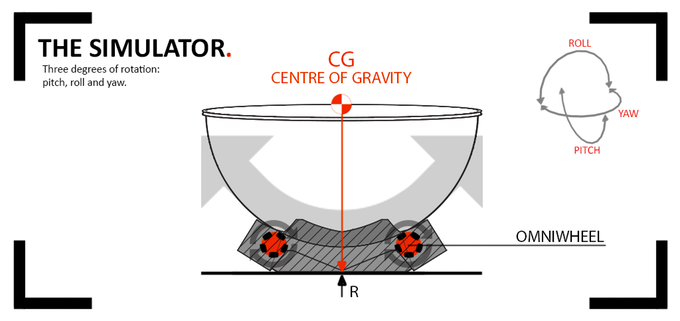Virtual reality tech is evolving day by day with respect to both software and hardware. Users can feel sight and audio in the virtual immersive world, but now technologists are building hardware that will allow the human body to perform and physically feel and act in virtual experiences and games. Feel Three is one of the virtual reality motion simulators with 3DOF functionality which is working on the production of such hardware. They have manufactured a reasonably cost-effective hardware-tech in the VR motion platform market. Mark Towner, the project creator, explained
“It’s been a long 4 years to this point and it’s all for you guys. I promise to try my damn best to not screw it up and become another failed VR project. No distractions. No first class travel…. just first class vision. Your trust is well placed. Prepare to have your world moved!”
The structure of the hardware is standing on a hemisphere which has a base of multiple motors and omnidirectional wheels allowing user to enjoy freedom of three degrees that includes pitch, roll and left right movement. The heavy cost of actuators have been saved by an inexpensive idea design. Explaining the mechanism of machinery, the project founder said
“You’re lifting the user up and down [with linear actuators], which is really expensive mechanically—it takes a lot of power. So by using just Omni wheels and DC motors, we can move the user quite quickly. They sit at the center of gravity, they’re balanced. It’s just a simpler solution”

To feel the sense of touch, Feel Three placed tactile transducers at positions of your feet, hands and back. Their main purpose is it to create vibrations so that the player can feel more immersed in gameplay. Now that can be a hit of a sniper on your head or the overturning of car in virtual experience. VR technology always requires tracking aspect. Feel Three has fixed a tracker near player’s head to update the direction and cancels the simulator motion with respect to players view. Following are some of the ways which helps to achieve this feature,
Individual Game Support: A piece of code is added to read VR tracking to cancel the motion.
Native Engine Support: Developers can simply enable the feature from the programming engines like Unreal and Unity.
Native Support through the OpenXR Initiative: Unifying both VR software and hardware to a standard.
Now the players can fly, drive or may perform any physical exercise in virtual environment. The company has also given another feature of removable armrest so you can change controllers easily. For popular controllers pre-drilled holes are present. Still the company has provided the chart to make your own setup. Mark Towner also said,
“a lightweight optional shelf which is attached to both armrests and can be rotated forward to let the user enter the cockpit.”
A software suite will be provided by the company to control the Feel Three. In this way the speed, intensity and physical rotation limit of games can be adjusted by the user. The goal was to achieve the funding of $57552.30 which in the end got the funding of $237,000. A big wow for the ultimate efforts of Feel Three. VR with its accessories will definitely change the ways of our lives.
